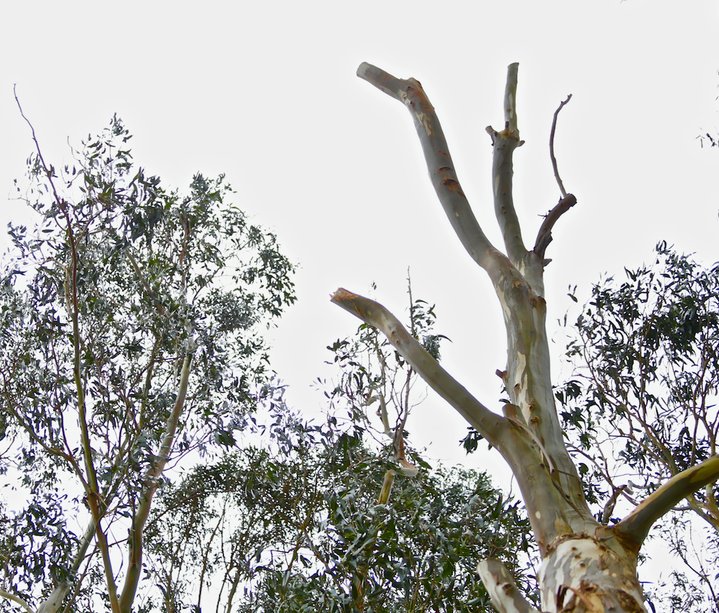
No one was working along the stand of eucalyptus earlier this afternoon, though Caltrans says that it will continue to trim trees along the corridor. Photos: Andrew Goff.
###
PREVIOUSLY:
###
Caltrans has officially pressed pause on its plans to remove 38 eucalpytus trees along Highway 101 between Eureka and Arcata, after California Coastal Commission staff objected to the work shortly after the project began Tuesday afternoon.
However, the state transportation agency will continue to remove limbs from several of the trees belonging to the landmark windbreak along the safety corridor, and a spokesperson told the Outpost today that it will recommence its plans to take down the trees slated for removal after 10 days.
According to Bob Merrill, the Coastal Commission’s district manager for the local region, commission staffers were taken aback when Caltrans began work Tuesday morning, without so much as notifying the commission that they were considering such a project.
In normal circumstances, Merrill told the Outpost, work that entails a major removal of vegetation in the state’s Coastal Zone would require a development permit to be issued by the Coastal Commission’s board, which meets once a month. Significant documentation is generally required to support the issuance of such a permit.
There are provisions within the Coastal Act that allow project managers to expedite that process in cases of emergency. In such cases, those managers may apply for an emergency permit by detailing the nature of a particular threat to public safety and proposing emergency measures to stop that threat. Such emergency permits can be approved by Coastal Commission staff without having to go the the more onerous process of a hearing before the Commission itself, Merrill said, and can usually be processed within a few days.
But Caltrans did not go that route either, instead relying on its own authority to begin work under an “emergency permit waiver” situation, according to Merrill. He said that public agencies may decide to undertake work under these conditions in cases where there is a truly imminent threat to public safety — when there is no time to wait even for an emergency permit — although any public agency that goes this route must still justify itself to the Commission at a later date.
Caltrans brought an arborist in to study the health of the trees more than three months ago. A county performed a similar study with an independent arborist in the fall of 2018.
Merrill said that Coastal Commission staff were able to meet with Caltrans staff on the day the eucalyptus work began, and were able to acquire the material that Caltrans was using to argue that the trees posed an imminent threat to public safety — mainly, they say, diseased or weakened trees pose a hazard to passing motorists, especially during winter storms.
During that meeting, Merrill said, Caltrans agreed not to remove any of the 38 trees for the time being. Merrill said that his staff, in the meanwhile, is reviewing the materials the received from Caltrans, and should shortly be able to determine whether or not they would qualify for emergency removal under the terms of the Coastal Act.
“So far, it does look like there are some really bad trees that do pose a hazard,” Merrill said.
Myles Cochrane, a spokesperson for Caltrans District 1, confirmed this afternoon that the agency had agreed to a temporary moratorium on the outright removal of trees, and defended the decision to proceed in the most expeditious fashion possible — that is, outside the usual Coastal Commission process.
“We are comfortable in our stance that time is of the essence in this project, and that it will ultimately enhance safety,” Cochrane said. “This was the fastest way.”
###

A tree that was limbed earlier this week.
CLICK TO MANAGE